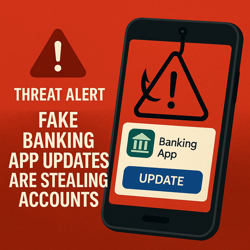
Cybercriminals are moving fast in 2025. A new phishing campaign is spreading that targets mobile banking users by disguising itself as a legitimate app update. If you’ve received a text or email telling you to “update your banking app now,” read carefully — it may be a scam.
🔎 How the Scam Works
Attackers are sending messages that look like they come directly from banks. The messages warn that your banking app needs an urgent update to avoid suspension. A link is provided that leads to a convincing fake website, often using the bank’s branding, colors, and even domain names that look official at first glance.
From there, users are tricked into downloading an app that looks identical to their normal banking app. Once installed, this malicious software collects:
- Your login credentials when you type them in.
- SMS-based verification codes (used in two-factor authentication).
- Sensitive details such as credit card numbers or personal information.
The result: criminals can take over accounts completely, transfer funds, and even lock victims out of their own accounts.
⚠️ Why This Scam Is So Dangerous
This campaign is more sophisticated than older phishing attempts. Here’s why:
- Realistic Branding – Logos, app icons, and even the interface look genuine. Many users don’t realize they’ve been tricked until money is gone.
- Bypassing Two-Factor Authentication – Because the fake app can read SMS messages, attackers intercept the one-time passcodes banks send, giving them instant access.
- Wide Target Range – While some scams focus on a single bank, this campaign targets multiple institutions, adapting messages for Android and iOS users worldwide.
- Speed of Attack – Stolen credentials are often used within minutes, leaving little time for victims to react.
In short: this isn’t the old “Nigerian prince” scam. It’s fast, professional, and very costly for those who fall for it.
🛡️ How to Stay Safe
The good news? You can protect yourself and your family with a few simple habits.
- Never update apps through links in messages.
Only use official app stores like Google Play or Apple’s App Store. If your bank app needs an update, you’ll see it there. - Check the sender carefully.
Banks rarely send urgent SMS updates. If a message seems suspicious, call the bank directly using the number on their official website. - Switch to authenticator apps.
Instead of SMS codes, use an app like Google Authenticator, Microsoft Authenticator, or Authy. These apps are harder for attackers to intercept. - Keep your phone security up to date.
Install the latest system updates and use a reputable mobile antivirus solution. - Stay alert for unusual activity.
Check your account balance frequently. If you see suspicious logins or charges, contact your bank immediately. - Report phishing attempts.
Forward scam texts and emails to your bank’s fraud team or your country’s cybercrime reporting service. Every report helps shut down these operations.
✅ Final Thoughts
Threats like this are spreading quickly in 2025. What makes them effective is not just the technology, but how real they look to the average person. By slowing down, double-checking links, and relying only on official app stores, you can protect yourself from losing money and sensitive data.
⚡ Action step for today: If you get a message asking you to update your banking app, delete it and update only through your app store.
👉 Share this Threat Alert with friends, coworkers, and family — because one informed person can prevent many others from becoming victims.
